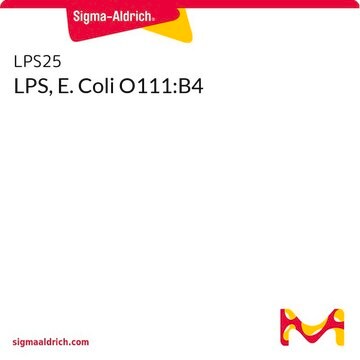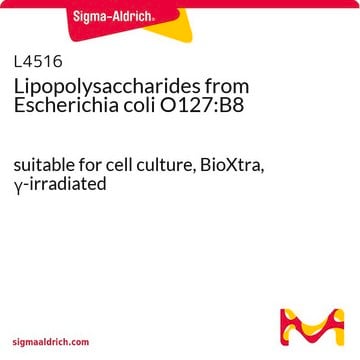If this product has an expiration or retest date, it will be shown on the Certificate of Analysis (COA, CofA). If there is no retest or expiration date listed on the product's COA, we do not have suitable stability data to determine a shelf life. For these products, the only date on the COA will be the release date; a retest, expiration, or use-by-date will not be displayed.
For all products, we recommend handling per defined conditions as printed in our product literature and website product descriptions. We recommend that products should be routinely inspected by customers to ensure they perform as expected.
For products without retest or expiration dates, our standard warranty of 1 year from the date of shipment is applicable.
For more information, please refer to the Product Dating Information document: https://www.sigmaaldrich.com/deepweb/assets/sigmaaldrich/marketing/global/documents/449/386/product-dating-information-mk.pdf
L5293
Lipopolysaccharide aus Escherichia coli O111:B4
Ready Made solution, 1 mg/mL
Synonym(e):
LPS
Größe auswählen
About This Item
Empfohlene Produkte
Biologische Quelle
Escherichia coli (O111:B4)
Qualitätsniveau
Form
aqueous solution
Konzentration
1 mg/mL
Farbe
colorless to faint yellow
Löslichkeit
water: soluble
Versandbedingung
wet ice
Lagertemp.
2-8°C
Suchen Sie nach ähnlichen Produkten? Aufrufen Leitfaden zum Produktvergleich
Anwendung
Biochem./physiol. Wirkung
Angaben zur Herstellung
Sonstige Hinweise
Ähnliches Produkt
Lagerklassenschlüssel
12 - Non Combustible Liquids
WGK
WGK 1
Flammpunkt (°F)
Not applicable
Flammpunkt (°C)
Not applicable
Persönliche Schutzausrüstung
Eyeshields, Gloves, multi-purpose combination respirator cartridge (US)
Hier finden Sie alle aktuellen Versionen:
Analysenzertifikate (COA)
Die passende Version wird nicht angezeigt?
Wenn Sie eine bestimmte Version benötigen, können Sie anhand der Lot- oder Chargennummer nach einem spezifischen Zertifikat suchen.
Besitzen Sie dieses Produkt bereits?
In der Dokumentenbibliothek finden Sie die Dokumentation zu den Produkten, die Sie kürzlich erworben haben.
Kunden haben sich ebenfalls angesehen
Artikel
Explore the structure, function, and diverse applications of Lipopolysaccharides. Discover their role in bacteria, serological specificity, and research potential.
Verwandter Inhalt
Lipopolysaccharide (LPS) is a major component of Gram-negative bacteria, important for microbiological research.
-
How can I determine the shelf life / expiration / retest date of this product?
1 answer-
Helpful?
-
-
How is shipping temperature determined? And how is it related to the product storage temperature?
1 answer-
Products may be shipped at a different temperature than the recommended long-term storage temperature. If the product quality is sensitive to short-term exposure to conditions other than the recommended long-term storage, it will be shipped on wet or dry-ice. If the product quality is NOT affected by short-term exposure to conditions other than the recommended long-term storage, it will be shipped at ambient temperature. As shipping routes are configured for minimum transit times, shipping at ambient temperature helps control shipping costs for our customers. For more information, please refer to the Storage and Transport Conditions document: https://www.sigmaaldrich.com/deepweb/assets/sigmaaldrich/marketing/global/documents/316/622/storage-transport-conditions-mk.pdf
Helpful?
-
-
What is recommended for the storage of longer duration once opened? Is it better to keep at 2°C-8°C for 1-2 years or to freeze it (-80°C or -20°C) and thaw it gently when needed?
1 answer-
This product is stable at 2-8°C at least until the assigned retest date, provided that no contaminants have been introduced. The recommended retest date is lot specific and reported in the product Certificate of Analysis. The stability of the product in dilute form or beyond the assigned retest date has not been determined. However, LPS products prepared from the powder form may be stored in 1 mg/mL aliquots for up to 2 years at -20°C. The storage of solutions at -80°C has not been determined. Please see the link below to review additional information regarding the stability and preparation of Lipopolysaccharides:
https://www.sigmaaldrich.com/technical-documents/protocol/clinical-testing-and-diagnostics-manufacturing/bacteriology/lipopolysaccharidesHelpful?
-
-
What solvent is the product L5293-2ML dissolved in?
1 answer-
The solvent information for this product is proprietary, but it is acknowledged to contain water, while the remaining components remain undisclosed.
Helpful?
-
-
Bonjour, Comment ce LPS a t'il été extrait / Purifié ?
1 answer-
This product is a sterile filtered solution. The extraction method for this material is considered proprietary, however it is chromatographically purified.
Helpful?
-
Active Filters
Unser Team von Wissenschaftlern verfügt über Erfahrung in allen Forschungsbereichen einschließlich Life Science, Materialwissenschaften, chemischer Synthese, Chromatographie, Analytik und vielen mehr..
Setzen Sie sich mit dem technischen Dienst in Verbindung.




